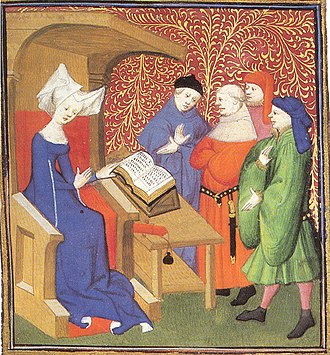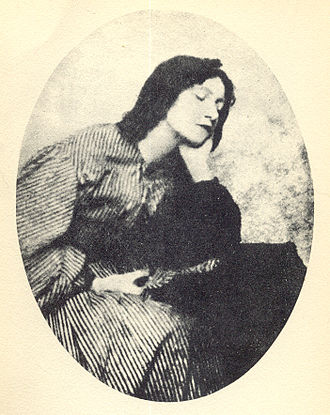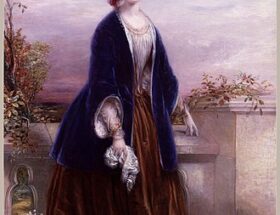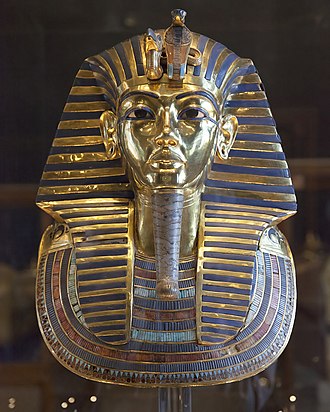
Early life
Christine de Pizan was born in September 1364 in the Republic of Venice, Italy. She was the daughter of Tommaso di Benvenuto da Pizzano. Her father became known as Thomas de Pizan, named for the family’s origins in the town of Pizzano, southeast of Bologna. He worked as a physician, court astrologer and Councillor of the Republic of Venice.
Thomas de Pizan accepted an appointment to the court of Charles V of France as the king’s astrologer and in 1368 Christine moved to Paris.
In 1379, Christine married the notary and royal secretary Etienne du Castel, with whom she had three children. Her daughter became a nun at the Dominican Abbey in Poissy in 1397 as a companion to the King’s daughter Marie.
Christine‘s husband died of the plague in 1389, a year after her father had died. This left Christine to support her mother and her children. When she tried to collect money from her husband’s estate, she faced complicated lawsuits regarding the recovery of salaries still owed to her husband.
On 4 June 1389, in a judgment concerning a lawsuit filed against her by the archbishop of Sens and François Chanteprime, councillors of the King, Christine was styled “damoiselle” and “widow of Estienne du Castel”.
Writing career
To support herself and her family, Christine became a court writer. By 1393, she was writing love ballads, which caught the attention of wealthy patrons within the court. Her involvement in the production of her books and her skilful use of patronage in turbulent political times has earned her the title of the first professional woman of letters in Europe.
Although Italian by birth, Christine expressed a fervent nationalism for France. Affectively and financially she became attached to the French royal family, donating or dedicating her early ballads to its members, including Isabeau of Bavaria, Louis I, Duke of Orléans, and Marie of Berry.
In 1402 she described Queen Isabeau as “High, excellent crowned Queen of France, very redoubtable princess, powerful lady, born at a lucky hour”.
France was ruled by Charles VI who experienced a series of mental breakdowns, causing a crisis of leadership for the French monarchy. He was often absent from court and could eventually only make decisions with the approval of a royal council.
Queen Isabeau was nominally in charge of governance when her husband was absent from court but could not extinguish the quarrel between members of the royal family. In the past, Blanche of Castile had played a central role in the stability of the royal court and had acted as regent of France. Christine published a series of works on the virtues of women, referencing Queen Blanche and dedicating them to Queen Isabeau.
Christine believed that France had been founded by the descendants of the Trojans and that its governance by the royal family adhered to the Aristotelian ideal. In 1400 she published L’Épistre de Othéa a Hector (Letter of Othea to Hector). When first published, the book was dedicated to Louis of Orléans, the brother of Charles VI, who was at court seen as potential regent of France.
In L’Épistre de Othéa a Hector Hector of Troy is tutored in statecraft and the political virtues by the goddess of wisdom Othéa. Christine produced richly illustrated luxury editions of L’Épistre de Othéa a Hector in 1400 and between 1408 and 1415 she produced further editions of the book.
Throughout her career Christine produced rededicated editions of the book with customised prologues for patrons, including an edition for Philip the Bold in 1403 as well as editions for Jean of Berry and Henry IV of England in 1404.
Patronage changed in the late Middle Ages. Texts were still produced and circulated as continuous roll manuscripts, but were increasingly replaced by the bound codex. Members of the royal family became patrons of writers by commissioning books. As materials became cheaper a book trade developed, so writers and bookmakers produced books for the French nobility, who could afford to establish their own libraries.
Christine thus had no single patron who consistently supported her financially and became associated with the royal court and the different factions of the royal family – the Burgundy, Orleans and Berry – each having their own respective courts. Throughout her career she undertook concurrent paid projects for individual patrons and subsequently published these works for dissemination among the nobility of France.
In 1402, Christine became involved in a renowned literary controversy, the “Querelle du Roman de la Rose”. She questioned the literary merits of Jean de Meun‘s popular Romance of the Rose, which satirizes the conventions of courtly love while critically depicting women as nothing more than seducers.
In the midst of the Hundred Years’ War between French and English kings, Christine wrote the dream allegory Le Chemin de long estude in 1403. Writing in the first-person, she and the Cumaean Sibyl travel together and witness a debate on the state of the world between the four allegories – Wealth, Nobility, Chivalry and Wisdom. Christine suggests that justice could be brought to earth by a single monarch who had the necessary qualities.
In 1404, Christine chronicled the life of Charles V, portraying him as the ideal king and political leader, in Le Livre des fais et bonnes meurs du sage roy Charles V. The chronicle had been commissioned by Philip the Bold of Burgundy and in the chronicle Christine passed judgment on the state of the royal court. When praising the efforts of Charles V in studying Latin, Christine lamented that her contemporaries had to resort to strangers to read the law to them.
Before the book was completed, Philip the Bold died, and Christine offered the book to Jean, Duke of Berry in 1405 in an attempt to find a new patron. She was paid 100 livres for the book by Philip the Bold‘s successor John the Fearless in 1406 and would receive payments from his court for books until 1412.
In 1405, Christine published Le Livre de la cité des dames (The Book of the City of Ladies) and Le Livre des trois vertus (Book of Three Virtues, known as The Treasure of the City of Ladies).
In Le Livre de la cité des dames Christine presented intellectual and royal female leaders, such as Queen Zenobia. Christine dedicated Le Livre des trois vertus to the dauphine Margaret of Nevers, advising the young princess on what she had to learn. As Queen Isabeau’s oldest son Louis of Guyenne came of age Christine addressed three works to him with the intention of promoting wise and effective government. The earliest of the three works has been lost.
In Livre du Corps de policie (The Book of the Body Politic), published in 1407 and dedicated to the dauphin, Christine set out a political treatise which analysed and described the customs and governments of late medieval European societies.
She favoured hereditary monarchies, arguing in reference to Italian city-states that were governed by princes or trade guilds, that “such governance is not profitable at all for the common good”. Christine also devoted several chapters to the duties of a king as a military leader and she described in detail the role of the military class in society.
Civil War
France was on the verge of a full-scale civil war beginning in 1405. In 1407 John I of Burgundy, also known as John the Fearless, plunged France into a crisis when he ordered the assassination of Louis of Orléans. The Duke of Burgundy fled Paris when his complicity in the assassination became known, but was appointed regent of France on behalf of Charles VI in late 1408 after his military victory in the Battle of Othee.
It is not certain who commissioned Christine to write a treatise on military warfare, but in 1410 she published the manual on chivalry, entitled Livre des fais d’armes et de chevalerie (The Book of Feats of Arms and of Chivalry). Christine received 200 livre from the royal treasury in early 1411 for the book.
In the preface Christine explained that she published the manual in French so that it could be read by practitioners of war not well versed in Latin. The book opened with a discussion of the just war theory advanced by Honoré Bonet. Christine also referenced classical writers on military warfare, such as Vegetius, Frontinus and Valerius Maximus.
Christine discussed contemporary matters relating to what she termed the Laws of War, such as capital punishment, the payment of troops, as well as the treatment of noncombatants and prisoners of war. Christine opposed trial by combat, but articulated the medieval belief that God is the lord and governor of battle and that wars are the proper execution of justice.
Nevertheless, she acknowledged that in a war “many great wrongs, extortions, and grievous deeds are committed, as well as raping, killings, forced executions, and arsons”. Christine limited the right to wage war to sovereign kings because as head of states they were responsible for the welfare of their subjects. In 1411 the royal court published an edict prohibiting nobles from raising an army.
After civil war had broken out in France, Christine in 1413 offered guidance to the young dauphin on how to govern well, publishing Livre de la paix (The Book of Peace). Livre de la paix was to be Christine‘s last major work and contained detailed formulations of her thoughts on good governance. The period was marked by bouts of civil war and failed attempts to bring John the Fearless to justice for assassinating his cousin. Christine addressed Louis of Guyenne directly, encouraging him to continue the quest for peace in France. She argued that “Every kingdom divided in itself will be made desolate, and every city and house divided against itself will not stand”.[42]
Christine was acquainted with William of Tignonville, an ambassador to the royal court, and referenced Tignonville‘s speeches on the Armagnac–Burgundian Civil War. She drew a utopian vision of a just ruler, who could take advice from those older or wiser. In arguing that peace and justice were possible on earth as well as in heaven, Christine was influenced by Dante, whom she had referenced in Le Chemin de long estude.
Christine encouraged the dauphin to deserve respect, by administering justice promptly and living by worthy example. She also urged young princes to make themselves available to their subjects, avoid anger and cruelty, to act liberally, mercifully and truthfully. Christine‘s interpretation of the virtuous Christian prince built on the advice to rulers by St Benedict, Peter Abelard and Cicero.
In 1414, Christine presented Queen Isabeau with a lavishly decorated collection of her works (now known as British Library Harley 4431). The bound book contained 30 of Christine‘s writings and 130 miniatures. She had been asked by the queen to produce the book. The work is noted for its quality miniature illuminations; Christine herself and her past royal patrons are depicted. As a mark of ownership and authorship the opening frontispiece depicts Queen Isabeau being presented with the book by Christine.
In 1418, Christine published a consolation for women who had lost family members in the Battle of Agincourt under the title Epistre de la prison de vie Humaine (Letter Concerning the Prison of Human Life). In it, Christine did not express any optimism or hope that peace could be found on earth; instead, she expressed the view that the soul was trapped in the body and imprisoned in hell. The previous year she had presented the Epistre de la prison de vie Humaine to Marie of Berry, the administrator of the Duchy of Bourbon whose husband was held in English captivity.
Historians assume that Christine spent the last ten years of her life in the Dominican Convent of Poissy because of the civil war and the occupation of Paris by the English. Away from the royal court her literary activity ceased. However, in 1429, after Joan of Arc‘s military victory over the English, Christine published the poem Ditié de Jehanne d’Arc (The Tale of Joan of Arc).
Published just a few days after the coronation of Charles VII, Christine expressed renewed optimism. She cast Joan as the fulfilment of prophecies by Merlin, the Cumaean Sibyl and Saint Bede, helping Charles VII to fulfill the predictions of Charlemagne.[48]
Death
Christine is believed to have died in 1430, before Joan was tried and executed by the English.
After her death the political crisis in France was resolved when Queen Isabeau‘s only surviving son Charles VII and John the Fearless‘ successor as Duke of Burgundy, Philip the Good, signed the Peace of Arras in 1435.
List of Works
- Enseignements moraux (1395)
- L’Épistre au Dieu d’amours (1399)
- L’Épistre de Othéa a Hector (1399–1400)
- Dit de la Rose (1402)
- Cent Ballades d’Amant et de Dame, Virelays, Rondeaux (1402)
- Le Chemin de long estude (1403)
- Livre de la mutation de fortune (1403)
- La Pastoure (1403)
- Le Livre des fais et bonnes meurs du sage roy Charles V (1404)
- Le Livre de la cité des dames (1405)
- Le Livre des trois vertus (1405)
- L’Avision de Christine (1405)
- Livre du corps de policie (1407)
- Livre des fais d’armes et de chevalerie (1410)
- Livre de paix (1413)
- Epistre de la prison de vie humaine (1418)
- Les sept psaumes allégorisés
- Ditié de Jehanne d’Arc (1429)


